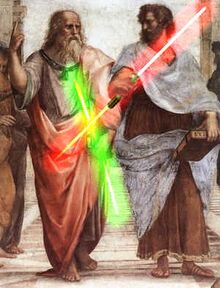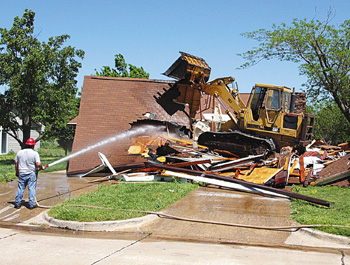Deconstruction

|
This page is currently under deconstruction This page contains too many great, white, heterosexual males and not enough antiracist mathematics. Please do not edit this page if you have essentially a Issac Newtonian, mechanistic world view: if you tend to believe that reality is objective, which is to say that it exists, "out there", absolutely independent of the human observer, and of the observer’s intentions and observations, or generally have no idea what postmodernists are talking about.
|

|
| Part of a series on |
| Philosophy |
|---|
 |
| Philosophers |
|
Ancient and Greek
|
|
19th-century
|
|
Americans
|
| Philosophies |
| Related |
|
|
Deconstruction is the philosophical belief that, in order to find the meaning of existence, all man-made constructions should be demolished. In particular, deconstructionists attack the notion of the brick-veneer 3 bedroom suburban home as a "signified stubbornly resisting the sliding of the signifier" and is read by deconstructionists everywhere as "plainly the tool of the Devil himself" as it relates to architectural innovation.
History[edit]
Deconstruction was first made popular in the 1960's by a French philosopher called Jacques Derrida, who announced that, after smoking some mouldy pot during a convention on the future of left-wing architecture in suburban Eastern Europe, "we must constantly question the logic of the brick built home, fighting for the demolition of houses everywhere, to free our culture from the oppression of accommodationcentrism (closely related to Derrida's other concepts of legocentrism and phallegocentrism - see below) that stifles true philosophical inquiry. Indeed, there being no outside of the text anyway, we should all quit our culturally hegemonizing, liberal capitalist structuralist abodes at once and return to the question of the sublime archia of living in trees if we are to find the true meaning of existence."
Since then, the deconstruction movement has swept across Europe and the U.S as a radical form of literary criticism that critiques especially the legitimacy of cannons and many other forms of heavy artillery. However, it is fiercely resisted by British academia which tend to describe the theory as "a load of bollocks. Whoever heard of demolishing houses as a means to philosophical enlightenment? What a load of bloody nonsense. Trust the French to come up with such crap."
Deconstructionist writing[edit]
One of the most famous books on deconstruction is "Writing and Difference" by Jacques Derrida. Although many people have read it, no one has ever actually understood a word of it. Some deconstruction theorists say this is because meaning is, like housing mortgage rates, forever changing and shifting and can never be pinned down. Others claim that the problem lies in Derrida's own writing style, which is so unwieldy and incomprehensible no one can ever be expected to understand a word of what he says anyway.
Nevertheless, many philosophy students have found that by careful mimicry of Derrida's style, they can often gain high results for submitted essays without actually saying or arguing anything. Students who mimic Derrida's style to get high results are commonly known as "Derrida sluts."
Although deconstructionist writing is notoriously hard to understand, one used to be able to spot a deconstructionist text by its title. Unlike most titles, deconstructionist titles usually comprise two unrelated and vaguely poetical sounding independent clauses, separated by a gratuitous colon, as in:
- "Stiegler Reading Derrida: The Prosthesis of Deconstruction in Technics" (by Ben Roberts);
- "Fear of Falling Sideways: Alexander Payne's Rhetoric of Class" (by Derek Nystrom);
- "Demystifying the Digital, Re-animating the Book: A Digital Poetics" (by Lori Emerson);
and the now-classic:
- "The Postfeminist Ethics of Jouissance: the Sublime Excesses of Daily Masturbation" (by Jieux de Chance)
However, as such titles have become increasingly trendy and fashionable over time, this practice has tended to cross disciplines. Thus, what looks like a deconstructionist text may be a simple guide on how to cook two-minute noodles. Although a major breakthrough of deconstruction was to discover that all texts are equally valid, there are other clues to help identify a deconstructionist text, as opposed to a similar work such as a thesaurus:
- Look for forward slashes. Deconstructionists love to feign ambiguity and "attack" meaning and binary oppositions, drawing subtle connections of excessive meaning, by inserting froward slashes between two terms which appear at first glance, totally unrelated to the average reader. This practice was started by a philosopher called Foucault, who although not a deconstructionist himself, is avidly worshipped by them anyway, because he was sexually adventurous, took a lot of drugs and was just a really cool, rebellious kinda gaylord.
- Examples: "power/knowledge", "sexy/ideology", "religio-contextual/beer" and of course, "discourse/boring philosophy lecture"
- Deconstructionists are also very prone to undermining and challenging meaning by making up new words. Most of these sound like meaningful words because they will take a root morpheme (such as the "log-" of the famous "logos") and add numerous prefixes and suffixes, in the meantime creating totally new compound nouns and adjectives by randomly adding the odd hyphen here and there. Watch out especially for the prefixes "neo-" and "post-", the adjectival suffix "-io" (often followed by a hyphen) and, most feared of all, the noun suffix "-ism". In this way the reader is presented with numerous meaningless neologisms which, although impressive sounding, tend to leave him utterly confounded, which was after all, the original idea.
- Example: "Post-phalleologicointricadeoneoculturalideosuprapostcontextualinter-chimerism" Yes. It's really one word.
- Sentences and passages of sentences containing as many coordinating, subordinating and relative clauses as possible, which in turn contain as many prepositional phrases as possible; so that the mind simply reels and shuts down after attempting to read one of them.
- Example: "The promotion of consciousness as being essential to the subject in the historical after-effects of the Cartesian cogito being for me the deceptive accentuation of the transparency of the I in action at the expense of the opacity of the signifier that undermines the I; and the sliding movement (glissement) by which the Bewusstsein serves to cover up the confusion of the Selbst eventually reveals, with all Hegel's own rigour, the reason for his error in the Phenomenology of Mind." (Jacques Lacan) (This sentence has no less than 7 clauses, one of which has no less than 6 prepositional phrases: certain clues that you are reading deconstructionist writing.)
- The adverb "always already".
- Example: "From then on it became necessary to think the law which governed, as it were, the desire for the center in the constitution of structure and the process of signification prescribing its displacements and its substitutions for this law of the central presence-but a central presence which was never itself, which has always already been transported outside itself in its surrogate." (Jacques Derrida)
Practical examples[edit]
Although deconstruction is mainly a theoretical, academic pursuit, there are some spectacular real world examples of applied deconstruction.
One of the main concerns of deconstructionists is with "centers" of all kind. Deconstructionists might be labelled as vehemently "centrophobic"; such is their distrust, hatred and fear of centers of all kinds, especially constructed city centers. These concepts are laid out in the deconstructionist theories of "Legocentrism" (the idea that Lego toys are really just an ideological front to instil and perpetuate the cultural myth of the supremacy of the built dwelling in children), and "Phallegocentrism" (the idea that Lego toys are really a cultural tool symbolizing the Lacanian Phallus by which boys are indoctrinated to impress/oppress women).
The deconstructionist Michael Bryson sums this loathing of centrism up well when he writes that, "...deconstruction, seeks to explode the notion that there is any necessary, a priori, transcendent "center" of any structure."
This theory was dramatically tested by the deconstructionist terrorist group Al Queda on September 11, 2001, when it hijacked two civilian planes, flying them into the twin towers of New York's World Trade Center, thereby causing them to spectacularly deconstruct, killing over 3000 people. Unfortunately, the USA did not take so kindly to this practical example of deconstruction, and ensuingly declared a fierce "War on Deconstructionism and -Isms of All Kinds, Including Terrorism" (more commonly known by its shorter form "War on Terror"), which has unfortunately not helped the spirit of deconstruction advance much at all since then.
